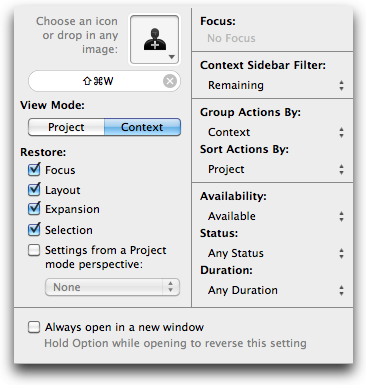OmniFocus : How To : Wait Better
In the ostensibly ideal world of the DIYer, every next action would depend solely on him. That’s not how life on earth is parameterized, though, is it? Here, on this planet, sometimes we have to wait (on others).
The productive perils of waiting
If only waiting were just waiting. Life would be so much easier. But we all know waiting usually means coming unglued. When things can’t go forward until someone else acts,
- projects stall
- people forget what they were waiting on
- places are lost (rework happens)
- waiting nags, gnaws at your attention
- opportunities for different approaches to the problem are missed
Hibernation happens.
Waiting (as efficiently as possible)
One of the most useful things I learned from Kourosh Dini’s book Creating Flow with OmniFocus was not how to act, but how to wait.
I have an OmniFocus context specifically for tasks where I’m waiting on something. It might be someone, some event, or for the completion of some other project. Normally I begin such tasks “Waiting for…” 1
The ‘Waiting’ context is the Saran wrap in my OmniFocus workflow. Whenever I put a project on the shelf because the ball’s not in my court, the next action’s context is ‘Waiting’.
Checking the waiting task off in a sequential project is like puncturing a preservative film and releasing all the fresh, active goodness back out.
Benefits of tracking the stuff you’re waiting on
There are several:
- You consciously acknowledge things that are beyond your control.
- You free your mind to work other things in your control.
- You think forward. You’re able to build out a series of actions that will be triggered once the waiting is over.
- A simple waiting perspective lets you regularly review, at a glance, every active project that’s currently in suspense (see below).
Start dates go great with waiting
In some cases, I know I’m going to be waiting for a while. For example, maybe I’m waiting on something that definitely won’t occur for the next two weeks. By setting the start date two weeks out, I get the whole project out of my way. I don’t need a daily reminder that I’m waiting on something thats not going to happen for a while.
The waiting perspective
I look at mine every day. Doesn’t take long, and it’s a super low stress way of keeping an eye on all the suspended animation in my goal progression.
My Waiting perspective shows me every available next action that has a ‘Waiting’ context.

A waiting case study: the phone tag
This happens to me all the time:
Next action: Call Steve to kick around ideas about iPad 3.
Result: Voicemail.
Next action: Waiting for Steve to call me back.
A day later: Missed call; voicemail.
Next action: Call Steve again to kick around ideas about iPad 3.
Result: Voicemail.
If you can turn a cold shoulder to my sarcasm for a moment, you’ll get the picture. Phone tag is one of those real world hamster wheels that makes you want to punch your GTD system in the face some days.
Don’t.
When I feel a game of phone tag ramping up, I stop checking things off. Instead, I just reword the next action as needed. “Call Steve” becomes “Waiting for Steve to call.” And the context goes from ‘Phone’ to ‘Waiting’, respectively.
No fancy GTD dancin' here, okay? The point is keep focus on the precise status of the project so that it’s always blatantly obvious what should happen next – and what happens after that.
You'll thank you later. Just wait and see.
- I wait so much that I use a TextExpander snippet,
wfthat expands to “Waiting for.” ↩
